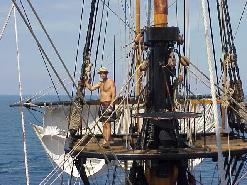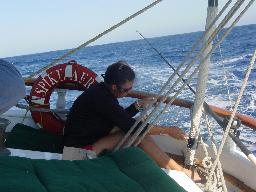Link to original post
vega 1860 said:
I want to stress that the following is what works for us. It might work for you or, then again, it might not.
We have a small boat, a Vega 27. I have lived aboard and sailed this boat since 1990. Laura joined me in 1996. We have never seen a boat that better meets our needs. Our thinking on equipment is to go with only what is necessary and nothing more. Of course this would be subject to individual interpretation but here is how we see it -
I don't believe that a pressure water system or shower has any place on a serious voyaging boat.
I think refrigeration adds unnecessary complication and draws too much electricity.
I think that a "Light and airy, spacious cabin" is dangerous in a sea boat.
Boat size: As big as one of us can handle alone without any mechanical or power assist; Can the smallest, weakest crew member raise the anchor without using the windlass or set the sails without using a winch?
Big enough to be comfortable living aboard and to hold enough gear and supplies for an extended voyage. Lealea easily holds six months provisions without spilling out of the lockers. We have a water maker, a Power Survivor 40e.
Big enough to entertain? Our boat sleeps two, feeds four and drinks six. Big enough for us.
Boat size and safety: To those who suggest that bigger is safer let me just mention "Titanic" and "Edmund Fitzgerald".
Dealing with it
Safety equipment: First let me say that we believe that no amount of money can buy safety. The most important piece of safety equipment is between your ears. It is paramount that all crew members maintain a safety first mindset at all times.
I have heard of some sailors who eschew PFDs and even lifelines. Not us. We rig additional lifelines and jack lines at sea, always wear our inflatable pfd/ harnesses on deck and always tether at night or when going forward and we never go forward unless the other crew member is in the cockpit. We carry an EPIRB, man-overboard pole and strobe and a heaving line but Rule 1 is "Don't fall off the boat".
Hand-holds: You can't have too many, inside or out.
We keep our flares, flare gun, parachute flares and smoke markers in a valise screwed to the underside of the lazarette hatch. Also in the valise are two US Navy die markers and a distress marker panel. There is a type III pfd secured to the underside of each of the two cockpit seat locker hatches with stretch cord. (Opening the three hatches with the flare valise and PFDs always impresses the Coasties)

We carry six fire extinguishers, two in the forward cabin where we sleep when in port or at anchor, two in the main cabin and two in the cockpit.
Our First aid kit is a US Navy item, very complete and well stocked. We have both had extensive first aid training. Every crew member should be able to deal with compound fractures, burns, severe cuts, poisoning and any known medical conditions such as heart problems, diabetes or allergies among the crew.
We both wear a sharp knife on a lanyard at all times at sea and there is a dive knife in a sheath attached to the base of the mast on deck.
We have three manual bilge pumps, all hose connections are double clamped with ss clamps with tapered soft wood plugs handy.
We include ground tackle as safety equipment. We carry two 10kg Bruce anchors and two 25 lb Danforths. The two Danforth anchors and one Bruce have a rode of 50 feet of chain and 250 feet of 1/2 inch three strand nylon rope. The remaining Bruce has 100 feet of 3/8 inch BBB chain and 300 feet of 5/8 inch three strand nylon (This last one does require mechanical advantage to weigh. If necessary we would slip the rode and buoy it). Two boat hooks also come in handy
We do not carry insurance.
Electronics: VHF radio plus one hand-held, depth sounder. That’s all folks. When radar systems get smaller and less expensive I may invest in one but for now we’ll do without.
Navigation: Best quality compasses possible, two bulkhead mounted and two hand-bearing. Two pairs of good quality 7X50 binoculars. Complete set of paper charts for the planned cruising area plus plotting tools (I like the Jeppeson plotter because I am a pilot. I also use a US Army Artillery plotting square, a steel ruler and traditional dividers. I don't like parallel rulers but you should use what ever tools you are comfortable with). I think you need an almanac but doubt the necessity of a sextant and HO249 tables (Although We do carry them). We carry three hand-held GPS receivers and plenty of batteries. Also tide and current tables and cruising guides like Charlie's Charts etc. The more information we can get about our destination the better. We also use a laptop computer with Maptech software and electronic charts and Google Earth for planning only.
Self steering: We carry a Tiller Pilot which comes in handy while motoring but Lealea has been known to steer herself under sail for up to three days, maintaining her course within ten degrees with just a piece of shock cord from the tiller to a windward cleat.
Spares: We carry enough new rope to replace the running rigging two or three times plus several blocks of various types and a handy billy. I used to carry a spare stay but have come to believe that standing rig failure can be dealt with using rope sufficiently well to reach port where more permanent repairs can be effected. We carry two water pump impellers for the engine and spare filter elements for engine and water maker.
Misc,: We have an electrical repair kit put together for us by an electrician friend cointaining wire of different sizes, an assortment of connectors, tape, tools etc. and a rigging box with spare shackles, clevis pins, cotter pins and monel seizing wire. Laura made a ditty bag for me that holds my marlinspike seamanship stuff. (Consult Hervey Garrett Smith for details) and enough hand tools to deal with anything I am capable of fixing.
Dingy: Difficult to work out with a small boat but essential. I think a two-part nesting dingy would be best but haven't found the right one yet. Hard dingy, oars, no outboard.
While the above may look like just another equipment list, it is actually an expression of our philosophy of self-sufficiency and minimalist cruising in terms of nuts and bolts. I am talking of actual voyaging as a lifestyle; exploring remote places and avoiding the crowds, as opposed to life in the marina. A suitable boat could be bought and fitted out as described above for fifteen thousand dollars. As a couple, cruising and anchoring out, we could manage quite well on six or seven hundred dollars a month without sacrificing comfort or safety to our standards.
A more common view of “Cruising” involves traveling by boat from one marina to the next, perhaps with an occasional sojourn in an anchorage, entertaining aboard, cocktails at the yacht club and dinner at waterfront restaurants. You may want to bring guests along or children. Our way won’t work for you. That’s fine, it’s a big tent. In fact, we are doing a little of both. We like restaurants and cocktails too and are presently comfortably ensconced in a big-city marina while we rebuild our cruising kitty. Our future cruising plans include Alaska, Mexico, the Galapagos, French Polynesia and some of the more remote and lesser known parts of the Pacific.
Our sailing CV:
I have sailed and crewed on sport fishing boats in the Hawaiian islands since 1980. I have lived aboard the Vega 27 "Lealea" since 1990 and with Laura since 1996. Together we have cruised the islands extensively.
We spent our honeymoon as crew members aboard the 151 ft LOA Australian square-rigger "Endeavour" 21 days from Vancouver BC to Kailua-Kona Hawaii. Laura sailed an additional three weeks to Fiji


Laura also crossed the Pacific from San Diego to Nawiliwili, Kauai as delivery crew in the 70 foot traditional wooden schooner "Spike Africa"

And, of course, we sailed Lealea from Honolulu to Neah Bay, WA, then to Port Townsend and Friday Harbor, cruising the San Juans and Channel Islands as far North as Maple Bay, BC before sailing to Seattle where Laura is currently managing a West Marine store.
Video logs
Details of our boat here and here
No comments:
Post a Comment